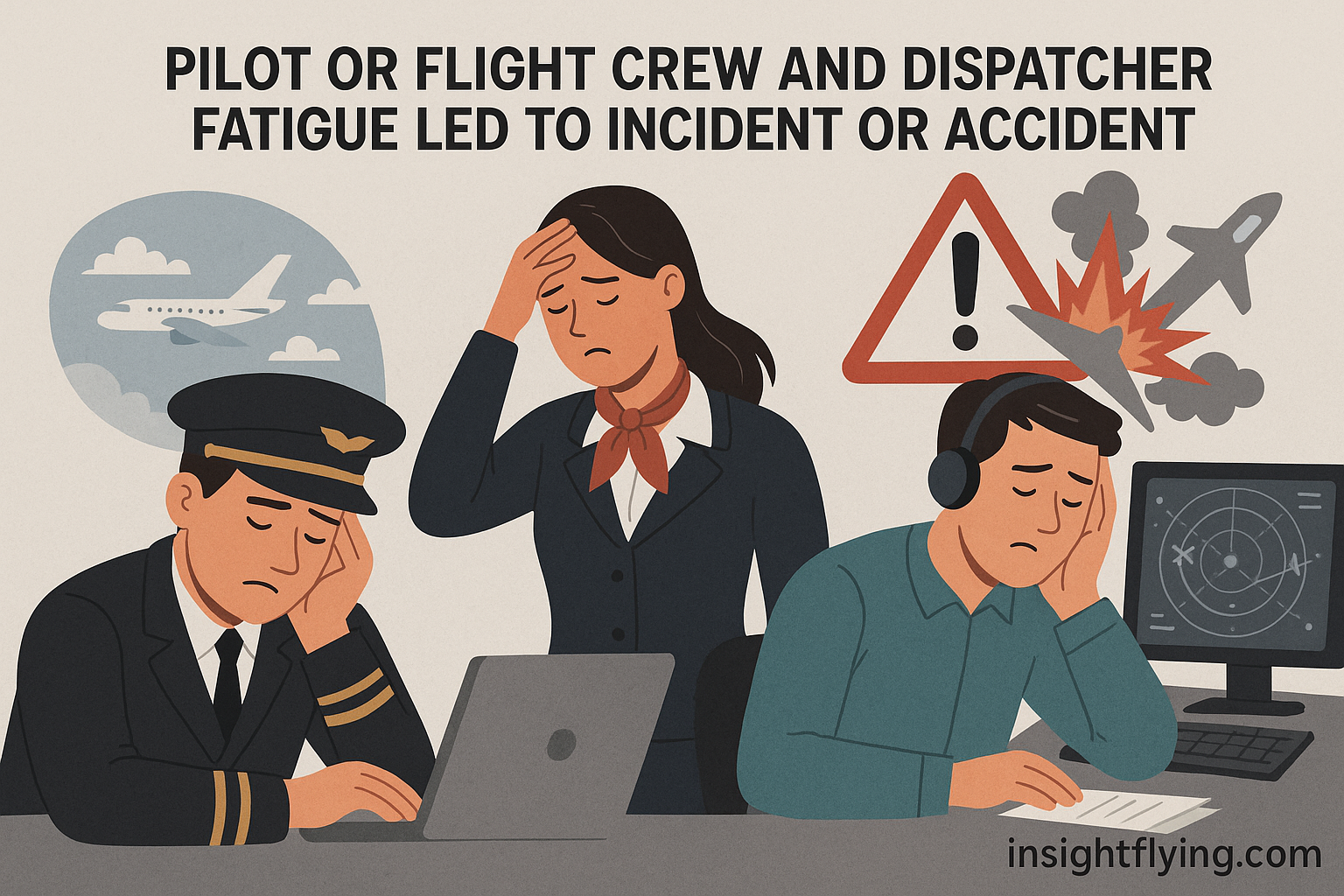ที่ insightflying.com เรามุ่งมั่นสร้างวัฒนธรรมด้านความปลอดภัยในการบิน หนึ่งในความเสี่ยงที่มักถูกประเมินต่ำกว่าความเป็นจริงก็คือ ความเหน็ดเหนื่อยล้า (Fatigue) ซึ่งถูกระบุว่าเป็นปัจจัยสำคัญที่ก่อให้เกิดเหตุการณ์และอุบัติเหตุทางการบินหลายครั้งทั่วโลก การเข้าใจความเสี่ยงคือก้าวแรก — การรายงานคือการกระทำที่ช่วยรักษาชีวิต
พื้นฐาน: ความเหน็ดเหนื่อยล้าและความปลอดภัยการบิน
อุตสาหกรรมการบินเป็นงานที่มีความเสี่ยงสูงและพึ่งพาประสิทธิภาพของมนุษย์อย่างมาก แตกต่างจากระบบกลไกที่มีความเสถียร ประสิทธิภาพของมนุษย์แปรผันตามปัจจัยต่าง ๆ เช่น การนอนหลับ ภาระงาน ความเครียด และจังหวะชีวภาพ (Circadian Rhythm)
ความเหน็ดเหนื่อยล้าส่งผลกระทบต่อทักษะสำคัญของนักบินและพนักงานอำนวยการบิน (Dispatcher):
- การตระหนักรู้ต่อสถานการณ์ (Situational Awareness)
- การสื่อสาร (Communication)
- การตัดสินใจ (Decision-Making)
- เวลาการตอบสนอง (Reaction Time)
- การประเมินความเสี่ยง (Risk Assessment)
ด้วยเหตุนี้ การจัดการความเหน็ดเหนื่อยล้า (Fatigue Risk Management) จึงกลายเป็นส่วนสำคัญของ ระบบการจัดการความปลอดภัยการบิน (Safety Management System – SMS)
🔗 อ้างอิง: ICAO Fatigue Management Guide for Airline Operators
ปัจจัยที่ก่อให้เกิดความเหน็ดเหนื่อยล้า
ความเหน็ดเหนื่อยล้าไม่ได้เกิดขึ้นทันที แต่สะสมมาจากหลายปัจจัย ทั้งด้านการปฏิบัติการและปัจจัยส่วนบุคคล เช่น:
- ชั่วโมงการทำงานที่ยาวนาน และการพักผ่อนไม่เพียงพอ
- การปฏิบัติงานกลางคืน ซึ่งรบกวนจังหวะชีวภาพ
- การเปลี่ยนเขตเวลา (Jet Lag) จากเที่ยวบินไกลหรือเวลาทำงานที่ไม่สม่ำเสมอ
- ภาระงานสูง เช่น การเบี่ยงเส้นทางเพราะสภาพอากาศหรือเหตุขัดข้องของระบบ
- งานที่ซ้ำซาก ในช่วงโหลดงานต่ำ ทำให้ความตื่นตัวลดลง
- ปัจจัยส่วนบุคคล เช่น การนอนหลับที่ไม่มีคุณภาพ ความเครียด หรือปัญหาสุขภาพ
🔗 อ้างอิง: FAA Fatigue Risk Management in Aviation Maintenance
กรณีศึกษา: ความเหน็ดเหนื่อยล้าที่เชื่อมโยงกับอุบัติเหตุ
เที่ยวบิน Colgan Air 3407 (2009)
- เครื่อง Bombardier Dash 8 Q400 ตกขณะเข้าใกล้สนามบินบัฟฟาโล รัฐนิวยอร์ก
- การสืบสวนพบว่า ความเหน็ดเหนื่อยล้าของนักบิน เป็นปัจจัยที่มีส่วนทำให้เกิดอุบัติเหตุ โดยกัปตันมีการเดินทางยาวก่อนเข้าปฏิบัติหน้าที่และพักผ่อนไม่เพียงพอ
- ความเหน็ดเหนื่อยล้าส่งผลให้การตระหนักรู้ต่อสถานการณ์และการตัดสินใจในขณะแก้ไขภาวะ失速 (Stall Recovery) ลดลง
- ผลลัพธ์: ผู้เสียชีวิต 50 ราย และทำให้กฎเกณฑ์การจัดการความเหน็ดเหนื่อยล้าเข้มงวดยิ่งขึ้น
🔗 อ้างอิง: NTSB Accident Report AAR-10/01 – Colgan Air 3407
ตัวอย่างอื่น ๆ:
- รายงานจาก NASA ASRS (Aviation Safety Reporting System) หลายฉบับ แสดงให้เห็นเหตุการณ์เฉียดอุบัติเหตุที่เกิดจากความเหน็ดเหนื่อยล้า
- ICAO และ IATA ต่างยืนยันว่าความเหน็ดเหนื่อยล้าเป็น “ภัยคุกคามด้านสมรรถนะมนุษย์” ที่ต้องได้รับการจัดการอย่างจริงจัง
🔗 อ้างอิง: NASA ASRS Fatigue Reports
🔗 อ้างอิง: IATA Fatigue Risk Management
ทำไมการรายงานจึงสำคัญ
- ทุกการรายงานความเหน็ดเหนื่อยล้า ช่วยให้ฝ่ายปฏิบัติการสามารถ ปรับตารางบินและเวลาพัก ได้เหมาะสมยิ่งขึ้น
- รายงานทั้งหมดเป็น ความลับ และใช้เพื่อ การปรับปรุงความปลอดภัยเท่านั้น
- การรายงานคือการปกป้องทั้งตัวคุณ เพื่อนร่วมงาน เครื่องบิน และผู้โดยสาร
ลงมือทำทันที
- หากคุณรู้สึกเหน็ดเหนื่อยล้า รายงานทันที ผ่านระบบที่กำหนด
- สนับสนุนเพื่อนร่วมงานที่อาจกำลังเผชิญความเหน็ดเหนื่อยล้า
- ตระหนักว่า ความเป็นมืออาชีพคือการยอมรับข้อจำกัดของมนุษย์
จำไว้ว่า:
การรายงานความเหน็ดเหนื่อยล้า = การปกป้องชีวิต
ความปลอดภัยไม่ได้ขึ้นอยู่กับเทคโนโลยีเท่านั้น แต่เริ่มต้นจาก “คน” การรายงานความเหน็ดเหนื่อยล้าอย่างตรงไปตรงมาคือมาตรฐานสูงสุดของความปลอดภัยในการบิน
Fatigue Reporting = Flight Safety
At insightflying.com, our mission is to strengthen aviation safety culture. One of the most persistent yet underestimated risks is fatigue. Fatigue has been identified in numerous investigations as a key contributing factor to incidents and accidents worldwide. Understanding this risk is the first step—reporting it is the action that saves lives.
Background: Fatigue and Aviation Safety
Aviation is a safety-critical industry where human performance is essential. Unlike mechanical systems, human performance varies with factors such as sleep, workload, stress, and circadian rhythm.
Fatigue impairs the very skills pilots and dispatchers rely on:
- Situational awareness
- Communication
- Decision-making
- Reaction time
- Risk assessment
Because safety depends on sharp judgment and quick responses, fatigue risk management has become a central part of modern Safety Management Systems (SMS).
🔗 Reference: ICAO Fatigue Management Guide for Airline Operators
Contributing Factors to Fatigue
Fatigue does not appear suddenly—it builds through multiple operational and personal factors. Common contributors include:
- Extended duty hours and insufficient rest between shifts.
- Night operations and circadian rhythm disruption.
- Time zone changes from long-haul or irregular schedules.
- High workload periods (e.g., weather diversions, system failures).
- Monotony during low workload phases, reducing alertness.
- Personal lifestyle factors such as poor sleep hygiene, stress, or illness.
🔗 Reference: FAA Fatigue Risk Management in Aviation Maintenance
Case Study: Fatigue in Real Incidents
Colgan Air Flight 3407 (2009)
- A Bombardier Dash 8 Q400 crashed on approach to Buffalo, New York.
- Investigation revealed that pilot fatigue was a contributing factor. The captain had commuted overnight and likely had insufficient rest before duty.
- Fatigue impaired situational awareness and decision-making during the stall recovery.
- Result: 50 fatalities and renewed emphasis on fatigue risk management regulations.
🔗 Reference: NTSB Accident Report AAR-10/01 – Colgan Air 3407
Other examples:
- Numerous NASA ASRS (Aviation Safety Reporting System) submissions highlight near misses where fatigue reduced attention or delayed decision-making.
- ICAO and IATA have both identified fatigue as a “human performance hazard” requiring proactive management.
🔗 Reference: NASA ASRS Fatigue Reports
🔗 Reference: IATA Fatigue Risk Management
Why Reporting Matters
- Every fatigue report gives operations the data to adjust scheduling and duty rosters.
- Reports are confidential and used for safety improvements only.
- By reporting, you protect not only your own wellbeing but also your colleagues, aircraft, and passengers.
Take Action Now
- Report fatigue immediately using the company system.
- Support colleagues who may be experiencing fatigue.
- Recognize that professionalism includes acknowledging human limitations.
Remember:
Reporting fatigue = Protecting lives.
Safety is not just about technology—it begins with people. By reporting fatigue honestly and without hesitation, pilots and dispatchers uphold the highest standard of aviation safety.
หนังสือการบิน ทางลัดสู่ความเข้าใจที่นำไปใช้งานจริง

|
|

|
|

|
|

|
|

|
|
ขายดีที่สุด

|
|
